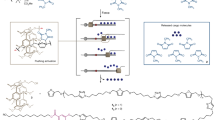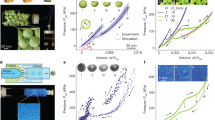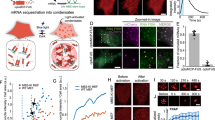Abstract
Proteins provide essential functional regulation of many bioprocesses across all scales of life; however, new techniques to specifically modulate protein activity within living systems and in engineered biomaterials are needed to better interrogate fundamental cell signalling and guide advanced decisions of biological fate. Here we establish a generalizable strategy to rapidly and irreversibly activate protein function with full spatiotemporal control. Through the development of a genetically encoded and light-activated SpyLigation (LASL), bioactive proteins can be stably reassembled from non-functional split fragment pairs following brief exposure (typically minutes) to cytocompatible light. Employing readily accessible photolithographic processing techniques to specify when, where and how much photoligation occurs, we demonstrate precise protein activation of UnaG, NanoLuc and Cre recombinase using LASL in solution, biomaterials and living mammalian cells, as well as optical control over protein subcellular localization. Looking forward, we expect that these photoclick-based optogenetic approaches will find tremendous utility in probing and directing complex cellular fates in both time and three-dimensional space.

This is a preview of subscription content, access via your institution
Access options
Access Nature and 54 other Nature Portfolio journals
Get Nature+, our best-value online-access subscription
$29.99 / 30 days
cancel any time
Subscribe to this journal
Receive 12 print issues and online access
$259.00 per year
only $21.58 per issue
Buy this article
- Purchase on Springer Link
- Instant access to full article PDF
Prices may be subject to local taxes which are calculated during checkout






Similar content being viewed by others
Data availability
All pertinent experimental and characterization data are available within this manuscript and its associated Supplementary Information. Plasmids generated during the current study are available from the corresponding author upon reasonable request. Source data are provided with this paper.
References
Shekhawat, S. S. & Ghosh, I. Split-protein systems: beyond binary protein–protein interactions. Curr. Opin. Chem. Biol. 15, 789–797 (2011).
Spencer, D. M., Wandless, T. J., Schreiber, S. L. & Crabtree, G. R. Controlling signal transduction with synthetic ligands. Science 262, 1019–1024 (1993).
Farrar, M. A., Alberola-Ila, J. & Perlmutter, R. M. Activation of the Raf-1 kinase cascade by coumermycin-induced dimerization. Nature 383, 178–181 (1996).
Fegan, A., White, B., Carlson, J. C. T. & Wagner, C. R. Chemically controlled protein assembly: techniques and applications. Chem. Rev. 110, 3315–3336 (2010).
Levskaya, A., Weiner, O. D., Lim, W. A. & Voigt, C. A. Spatiotemporal control of cell signalling using a light-switchable protein interaction. Nature 461, 997–1001 (2009).
Kennedy, M. J. et al. Rapid blue-light-mediated induction of protein interactions in living cells. Nat. Methods 7, 973–975 (2010).
Kawano, F., Suzuki, H., Furuya, A. & Sato, M. Engineered pairs of distinct photoswitches for optogenetic control of cellular proteins. Nat. Commun. 6, 6256 (2015).
Spiltoir, J. I. & Tucker, C. L. Photodimerization systems for regulating protein–protein interactions with light. Curr. Opin. Struct. Biol. 57, 1–8 (2019).
Zakeri, B. et al. Peptide tag forming a rapid covalent bond to a protein, through engineering a bacterial adhesin. Proc. Natl Acad. Sci. USA 109, E690–E697 (2012).
Hartzell, E. J., Terr, J. & Chen, W. Engineering a blue light inducible SpyTag system (BLISS). J. Am. Chem. Soc. 143, 8572–8577 (2021).
Chin, J. W. Expanding and reprogramming the genetic code. Nature 550, 53–60 (2017).
Chen, P. R. et al. A facile system for encoding unnatural amino acids in mammalian cells. Angew. Chem. Int. Ed. 48, 4052–4055 (2009).
Ruskowitz, E. R. & DeForest, C. A. Proteome-wide analysis of cellular response to ultraviolet light for biomaterial synthesis and modification. ACS Biomater. Sci. Eng. 5, 2111–2116 (2019).
Yanagisawa, T. et al. Multistep engineering of pyrrolysyl-tRNA synthetase to genetically encode Nɛ-(o-azidobenzyloxycarbonyl) lysine for site-specific protein modification. Chem. Biol. 15, 1187–1197 (2008).
Serfling, R. et al. Designer tRNAs for efficient incorporation of non-canonical amino acids by the pyrrolysine system in mammalian cells. Nucleic Acids Res. 46, 1–10 (2018).
Ruskowitz, E. R. & DeForest, C. A. Photoresponsive biomaterials for targeted drug delivery and 4D cell culture. Nat. Rev. Mater. 3, 17087 (2018).
Wylie, R. G. et al. Spatially controlled simultaneous patterning of multiple growth factors in three-dimensional hydrogels. Nat. Mater. 10, 799–806 (2011).
Mosiewicz, K. A. et al. In situ cell manipulation through enzymatic hydrogel photopatterning. Nat. Mater. 12, 1071–1077 (2013).
DeForest, C. A. & Tirrell, D. A. A photoreversible protein-patterning approach for guiding stem cell fate in three-dimensional gels. Nat. Mater. 14, 523–531 (2015).
Grim, J. C. et al. A reversible and repeatable thiol–ene bioconjugation for dynamic patterning of signaling proteins in hydrogels. ACS Cent. Sci. 4, 909–916 (2018).
Shadish, J. A., Benuska, G. M. & DeForest, C. A. Bioactive site-specifically modified proteins for 4D patterning of gel biomaterials. Nat. Mater. 18, 1005–1014 (2019).
Broguiere, N. et al. Morphogenesis guided by 3D patterning of growth factors in biological matrices. Adv. Mater. 32, 1908299 (2020).
Batalov, I., Stevens, K. R. & DeForest, C. A. Photopatterned biomolecule immobilization to guide three-dimensional cell fate in natural protein-based hydrogels. Proc. Natl Acad. Sci. USA 118, e2014194118 (2021).
Hoyt, E. A., Cal, P. M. S. D., Oliveira, B. L. & Bernardes, G. J. L. Contemporary approaches to site-selective protein modification. Nat. Rev. Chem. 3, 147–171 (2019).
Shadish, J. A. & DeForest, C. A. Site-selective protein modification: from functionalized proteins to functional biomaterials. Matter 2, 50–77 (2020).
Agard, N. J., Prescher, J. A. & Bertozzi, C. R. A strain-promoted [3 + 2] azide-alkyne cycloaddition for covalent modification of biomolecules in living systems. J. Am. Chem. Soc. 126, 15046–15047 (2004).
DeForest, C. A., Polizzotti, B. D. & Anseth, K. S. Sequential click reactions for synthesizing and patterning three-dimensional cell microenvironments. Nat. Mater. 8, 659–664 (2009).
Arakawa, C. K., Badeau, B. A., Zheng, Y. & DeForest, C. A. Multicellular vascularized engineered tissues through user-programmable biomaterial photodegradation. Adv. Mater. 29, 1703156 (2017).
Badeau, B. A., Comerford, M. P., Arakawa, C. K., Shadish, J. A. & DeForest, C. A. Engineered modular biomaterial logic gates for environmentally triggered therapeutic delivery. Nat. Chem. 10, 251–258 (2018).
Guimaraes, C. P. et al. Site-specific C-terminal and internal loop labeling of proteins using sortase-mediated reactions. Nat. Protoc. 8, 1787–1799 (2013).
Shaner, N. C. et al. Improved monomeric red, orange and yellow fluorescent proteins derived from Discosoma sp. red fluorescent protein. Nat. Biotechnol. 22, 1567–1572 (2004).
Szymczak, A. L. et al. Correction of multi-gene deficiency in vivo using a single ‘self-cleaving’ 2A peptide-based retroviral vector. Nat. Biotechnol. 22, 589–594 (2004).
Sawano, A. & Miyawaki, A. Directed evolution of green fluorescent protein by a new versatile PCR strategy for site-directed and semi-random mutagenesis. Nucleic Acids Res. 28, E78 (2000).
Roberts, P. J. et al. Rho family GTPase modification and dependence on CAAX motif-signaled posttranslational modification. J. Biol. Chem. 283, 25150–25163 (2008).
Kumagai, A. et al. A bilirubin-inducible fluorescent protein from eel muscle. Cell 153, 1602–1611 (2013).
Kwon, J. et al. Bright ligand-activatable fluorescent protein for high-quality multicolor live-cell super-resolution microscopy. Nat. Commun. 11, 273 (2020).
To, T. L., Zhang, Q. & Shu, X. Structure-guided design of a reversible fluorogenic reporter of protein–protein interactions. Protein Sci. 25, 748–753 (2016).
Li, L., Fierer, J. O., Rapoport, T. A. & Howarth, M. Structural analysis and optimization of the covalent association between SpyCatcher and a peptide Tag. J. Mol. Biol. 426, 309–317 (2014).
Gouzel, K., Josette, P., Agnes, U. & Daniel, L. A bacterial two-hybrid system based on a reconstituted signal transduction pathway. Proc. Natl Acad. Sci. USA 95, 5752–5756 (1998).
Paulmurugan, R., Umezawa, Y. & Gambhir, S. S. Noninvasive imaging of protein–protein interactions in living subjects by using reporter protein complementation and reconstitution strategies. Proc. Natl Acad. Sci. USA 99, 15608–15613 (2002).
Paulmurugan, R. & Gambhir, S. S. Monitoring protein–protein interactions using split synthetic renilla luciferase protein-fragment-assisted complementation. Anal. Chem. 75, 1584–1589 (2003).
Hall, M. P. et al. Engineered luciferase reporter from a deep sea shrimp utilizing a novel imidazopyrazinone substrate. ACS Chem. Biol. 7, 1848–1857 (2012).
Dixon, A. S. et al. NanoLuc complementation reporter optimized for accurate measurement of protein interactions in Cells. ACS Chem. Biol. 11, 400–408 (2016).
Jullien, N., Sampieri, F., Enjalbert, A. & Herman, J. Regulation of Cre recombinase by ligand‐induced complementation of inactive fragments. Nucleic Acids Res. 31, e131 (2003).
Muzumdar, M. D., Tasic, B., Miyamichi, K., Li, L. & Luo, L. A global double-fluorescent Cre reporter mouse. Genesis 45, 593–605 (2007).
Keeble, A. H. et al. Approaching infinite affinity through engineering of peptide–protein interaction. Proc. Natl Acad. Sci. USA 116, 26523–26533 (2019).
Keeble, A. H. et al. DogCatcher allows loop-friendly protein–protein ligation. Cell Chem. Biol. 29, 339–350 (2021).
Wu, X.-L., Liu, Y., Liu, D., Sun, F. & Zhang, W.-B. An intrinsically disordered peptide–peptide stapler for highly efficient protein ligation both in vivo and in vitro. J. Am. Chem. Soc. 140, 17474–17483 (2018).
Fierer, J. O., Veggiani, G. & Howarth, M. SpyLigase peptide–peptide ligation polymerizes affibodies to enhance magnetic cancer cell capture. Proc. Natl Acad. Sci. USA 111, E1176–E1181 (2014).
Buldun, C. M., Jean, J. X., Bedford, M. R. & Howarth, M. SnoopLigase catalyzes peptide–peptide locking and enables solid-phase conjugate isolation. J. Am. Chem. Soc. 140, 3008–3018 (2018).
Lorand, L. & Graham, R. M. Transglutaminases: crosslinking enzymes with pleiotropic functions. Nat. Rev. Mol. Cell Biol. 4, 140–156 (2003).
Wong, S., Mosabbir, A. A. & Truong, K. An engineered split intein for photoactivated protein trans-splicing. PLoS ONE 10, e0135965 (2015).
Jumper, J. et al. Highly accurate protein structure prediction with AlphaFold. Nature 596, 583–589 (2021).
Baek, M. et al. Accurate prediction of protein structures and interactions using a three-track neural network. Science 373, 871–876 (2021).
Acknowledgements
We recognize T. Rapp and R. Francis for synthetic advice, J. Shadish for helpful discussion on molecular cloning, R. Gharios for forward-looking conversations, R. Bretherton for providing the SpyTag peptide and transgenic dermal fibroblasts, J. Davis for gifting the HEK-293T cells (originally acquired from the American Type Culture Collection; CRL-3216) and S. Edgar (in memoriam) for assistance with mass spectrometry. This work was supported by a CAREER Award (DMR 1652141 to C.A.D.) and grants (DMR 1807398 and CBET 1803054 to C.A.D.) from the National Science Foundation, as well as a Maximizing Investigators’ Research Award (R35GM138036 to C.A.D.) from the National Institutes of Health. Student fellowship support was provided by the Institute for Stem Cell and Regenerative Medicine (to B.G.M.-R.) and Mary Gates Endowment for Students (to A.C.S., C.H.B. and S.K.) at the University of Washington. Part of this work was conducted with instrumentation provided by the Joint Center for Deployment and Research in Earth Abundant Materials. The Thorlabs multiphoton microscope was acquired with and operated under support from the Washington Research Foundation and the University of Washington College of Engineering, Institute for Stem Cell and Regenerative Medicine and Departments of Chemical Engineering, Bioengineering, Chemistry and Biology.
Author information
Authors and Affiliations
Contributions
E.R.R. and C.A.D. conceived of and designed the experiments. E.R.R., B.G.M.-R., A.C.S., C.H.B., S.K. and J.R.F. performed the experiments. E.R.R., B.G.M.-R., A.C.S., S.K., C.H.B. and C.A.D. analysed the data and prepared the figures. E.R.R., B.G.M.-R. and C.A.D. wrote the paper.
Corresponding author
Ethics declarations
Competing interests
The authors declare no competing interests.
Peer review
Peer review information
Nature Chemistry thanks Cecile Echalier and the other, anonymous, reviewer(s) for their contribution to the peer review of this work.
Additional information
Publisher’s note Springer Nature remains neutral with regard to jurisdictional claims in published maps and institutional affiliations.
Extended data
Extended Data Fig. 1 Photoactivation of split UnaG with spatiotemporal precision in living cells through intracellular LASL.
a-c, Mask-based photolithography spatiotemporally directs UnaG reassembly within HEK-293T cell culture. a, Fluorescent images of culture dish with inlays of exposure boundary magnified. b, Individual cell UnaG/mCh signal quantified radially outwards from the photomask’s center, normalized to the average UnaG/mCh ratio in unexposed cells. Dashed line indicates exposure edge. c, Violin scatter plots of normalized UnaG/mCh ratios in light-(un)exposed regions. Light treatments, λ = 365 nm, 20 mW cm−2, 20 min. Asterisks denote conditions with statistically significant differences in signal (p < 0.0001, two-tailed unpaired t-tests). Similar results were independently achieved in 3 experimental replicates. Scale bars, 1 mm (a).
Supplementary information
Supplementary Information
Supplementary Figs. 1–16, methods 1–28 and Tables 1 and 2.
Supplementary Data 1
Statistical data for Supplementary Figs. 1, 3, 4, 6, 9–11 and 14–16.
Source data
Source Data Fig. 2
Source data for Fig. 2a,d.
Source Data Fig. 3
Source data for Fig. 3d,e,h,i.
Source Data Fig. 4
Source data for Fig. 4c–e,k.
Source Data Fig. 5
Source data for Fig. 5c,e,f.
Source Data Extended Data Fig. 1
Source data for Extended Fig. 1b,c.
Rights and permissions
Springer Nature or its licensor (e.g. a society or other partner) holds exclusive rights to this article under a publishing agreement with the author(s) or other rightsholder(s); author self-archiving of the accepted manuscript version of this article is solely governed by the terms of such publishing agreement and applicable law.
About this article
Cite this article
Ruskowitz, E.R., Munoz-Robles, B.G., Strange, A.C. et al. Spatiotemporal functional assembly of split protein pairs through a light-activated SpyLigation. Nat. Chem. 15, 694–704 (2023). https://doi.org/10.1038/s41557-023-01152-x
Received:
Accepted:
Published:
Issue Date:
DOI: https://doi.org/10.1038/s41557-023-01152-x
This article is cited by
-
Irreversible light-activated SpyLigation mediates split-protein assembly in 4D
Nature Protocols (2024)
-
Engineering native biological complexity from the inside–out and outside–in
Nature Chemical Engineering (2024)
-
SpyMask enables combinatorial assembly of bispecific binders
Nature Communications (2024)



